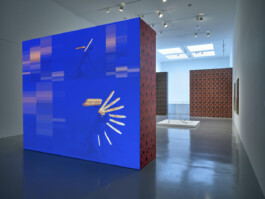Slinko
UB ART GALLERIES
Slinko’s animation Economy of Means draws on the relationship between economic abstraction and living bodies through labor and play. Golden loaves, bagels, and baguettes moving effortlessly and inexplicably across the screen welcome viewers with the exquisite allure of pure stuff. Then, two performers appear, manipulating these breads to make equal-signs, divisions, percentages, and square-roots. Their blue outfits conceal their features and render them nearly indistinguishable from their bluescreen background. They are universal bodies, average humans, and nobodies—abstractions, like shadows, specters, norms, and digital wireframes.
Viewers gradually realize that the breads are attached to parts of the performers’ bodies—the back of a hand, a forearm, a stomach. This shifts the relationship between body and bread: the loaves are not merely manipulated, they mirror movement- and productivity-tracking devices, tethering sustenance to performance. After a while, the performers transition to a synchronized dance. The screen eventually divides itself into smaller and smaller spaces and break into a fight: frames and figures vie for screenspace.
Bread, a food staple synonymous with minimal sustenance and bare life, has also long been used as an economic indicator with “bread units” serving to compare cost trans-historically. The Romans “bread and circus” dictum famously binds bread to body politics, survival, and entertainment. Economy of Means critically and humorously reworks this legacy.
BIOGRAPHY
Born in Ukraine, Slinko is a multidisciplinary artist living in the New York area. While her practice is informed by scholarship on labor, agency, and ideology, her inspiration comes from interactions with ordinary people, localized contexts, and material culture. Slinko often focuses on the anecdotal within larger historic events and political narratives to reflect on the effects and workings of power on society and individuals. Her work has been included in group exhibitions in Belgium, Canada, France, Germany, and the USA.
RESOURCES
Slinko
UB ART GALLERIES
Slinko’s animation Economy of Means draws on the relationship between economic abstraction and living bodies through labor and play. Golden loaves, bagels, and baguettes moving effortlessly and inexplicably across the screen welcome viewers with the exquisite allure of pure stuff. Then, two performers appear, manipulating these breads to make equal-signs, divisions, percentages, and square-roots. Their blue outfits conceal their features and render them nearly indistinguishable from their bluescreen background. They are universal bodies, average humans, and nobodies—abstractions, like shadows, specters, norms, and digital wireframes.
Viewers gradually realize that the breads are attached to parts of the performers’ bodies—the back of a hand, a forearm, a stomach. This shifts the relationship between body and bread: the loaves are not merely manipulated, they mirror movement- and productivity-tracking devices, tethering sustenance to performance. After a while, the performers transition to a synchronized dance. The screen eventually divides itself into smaller and smaller spaces and break into a fight: frames and figures vie for screenspace.
Bread, a food staple synonymous with minimal sustenance and bare life, has also long been used as an economic indicator with “bread units” serving to compare cost trans-historically. The Romans “bread and circus” dictum famously binds bread to body politics, survival, and entertainment. Economy of Means critically and humorously reworks this legacy.
BIOGRAPHY
Born in Ukraine, Slinko is a multidisciplinary artist living in the New York area. While her practice is informed by scholarship on labor, agency, and ideology, her inspiration comes from interactions with ordinary people, localized contexts, and material culture. Slinko often focuses on the anecdotal within larger historic events and political narratives to reflect on the effects and workings of power on society and individuals. Her work has been included in group exhibitions in Belgium, Canada, France, Germany, and the USA.





